Controlled burns, prescribed burns, and backfires are all similar terms for a wildland fire that is intentionally lit to create a natural firebreak in front of a main fire front, to reduce fuel buildup and decrease the potential for a hotter and more serious wildland fire, or to renew forest areas by stimulating germination of some trees and increasing seedling growth.
The drip torch often used in prescribed, controlled, and back burns is a model that is offered by WATERAX, which is manufactured by KCR Manufacturing in Oregon, an acquisition WATERAX made in 2018. Gary Da Silva, product manager for WATERAX, says that the model drip torch it offers is made to specifications laid down by the United States Forest Service (USFS).
"Our drip torch also meets Department of Transportation (DOT) specifications for transporting hazardous fuels because it is used to ignite controlled, prescribed, and back burns," Da Silva says. "Wildland firefighters use drip torches as a way to fight fire with fire through various controlled burn techniques which ignite vegetation along a control line ahead of the main fire thereby strengthening the control line. Backfiring attempts to stop the advance of a wildfire (or change its course) by burning up fuel in its path. The drip torch is also a common tool used in land management to perform prescribed burns which remove excess fuel buildup so that the underbrush isn't so thick that you have the potential for a catastrophic fire. They are likewise performed to re-create natural cycles of fire in an ecosystem. The WATERAX drip torch is made of lightweight aluminum alloy and is powder coated red. Da Silva points out that the drip torch "is designed to withstand the rough treatment that drip torches often endure in use in the field. The spout features a safety loop that is well away from the flame so there is no danger of the fuel in the loop (liquid seal) vaporizing from heat."
The WATERAX drip torch has a screw type vent valve that introduces air to the bottom of the tank to relieve the vacuum created as fuel is being used. The drip torch's wick is made of inserted fiberglass. "The unit has a hand-lifting handle that gives good balance in any position," Da Silva points out, is 1.2 U.S. gallons (one Imperial gallon or 4.7 liters) in size, and weighs five pounds (2.3 kilograms).
While the most common driver of controlled and prescribed burns is to prevent the loss of human life and reduce the risk of fatal fires by eliminating much of ground fuels before they can become a fuel ladder and begin an active crown fire, controlled burning, by reducing fuels, also can improve habitat for wildlife by eliminating competing nonnative vegetation, controlling tree disease, improving short-term grazing, and perpetuating fire-dependent species.

ALAN M. PETRILLO is a Tucson, Ariz.-based journalist, the author of three novels and five nonfiction books, and a member of the Fire Apparatus & Emergency EquipmentEditorial Advisory Board. He served 22 years with Verdoy (NY) Fire Department, including in the position of chief.
